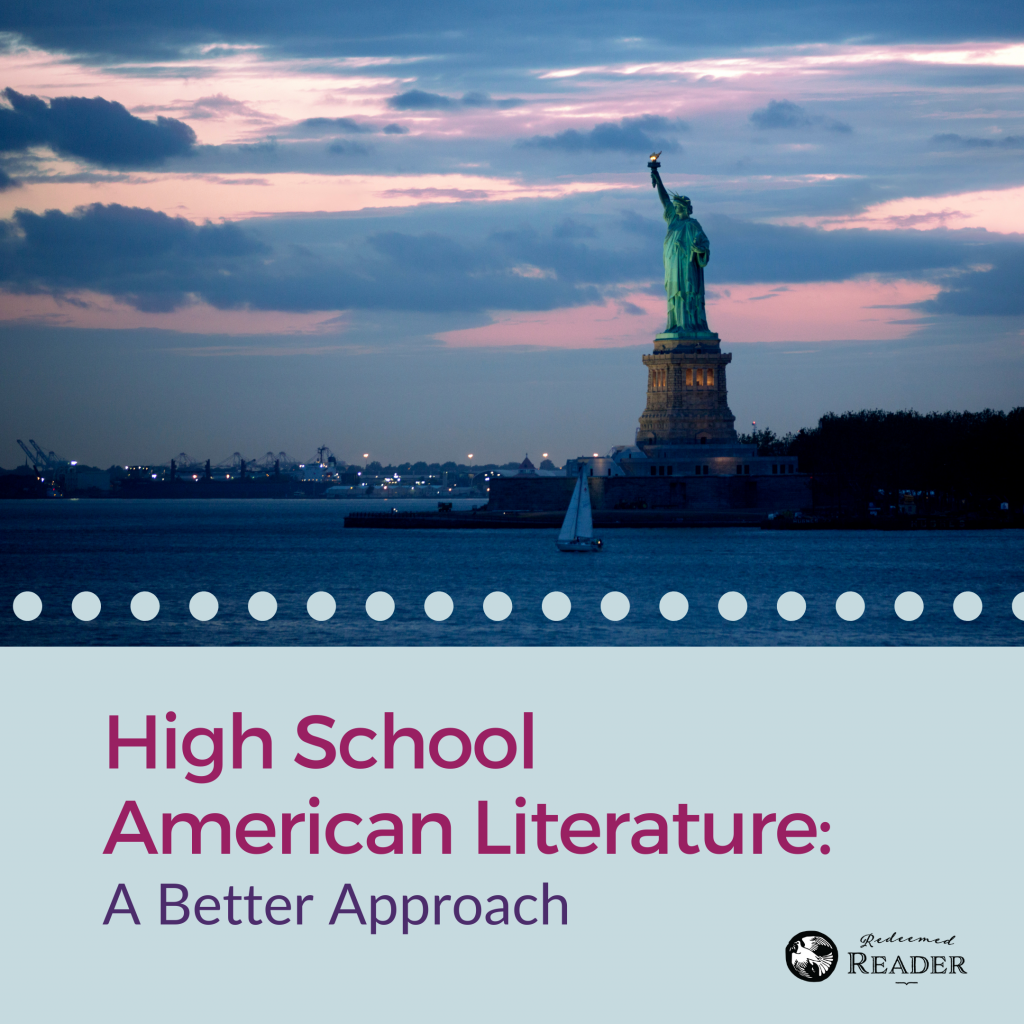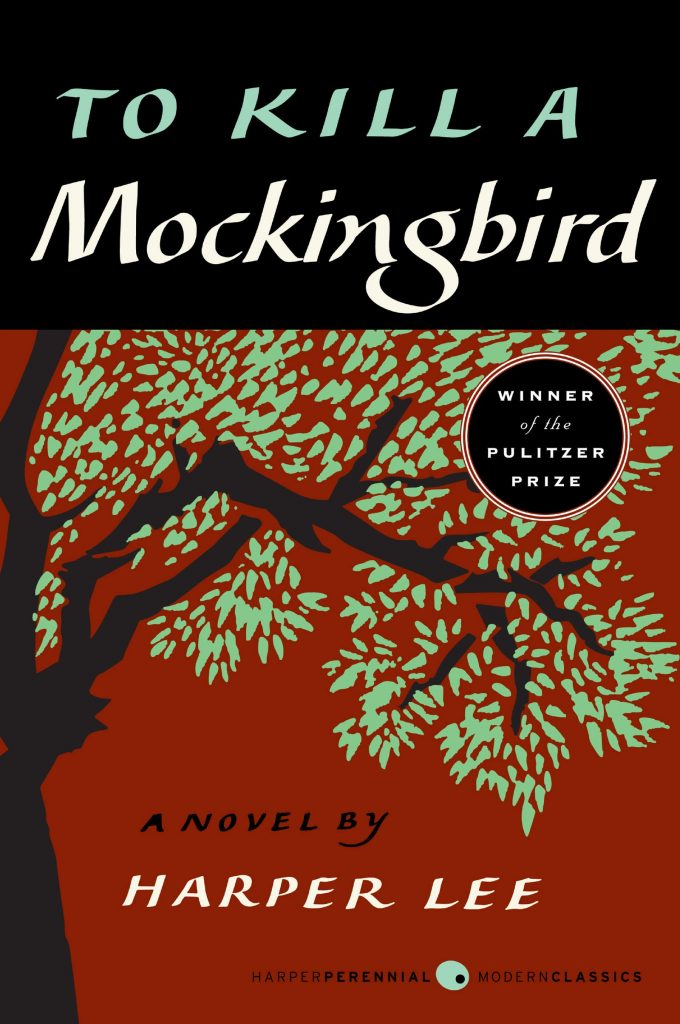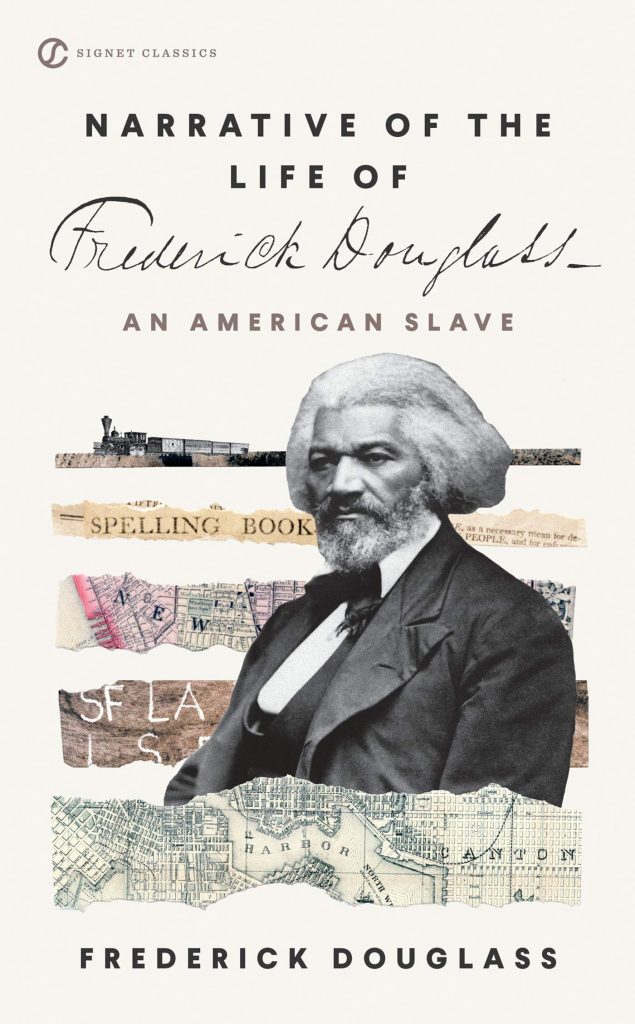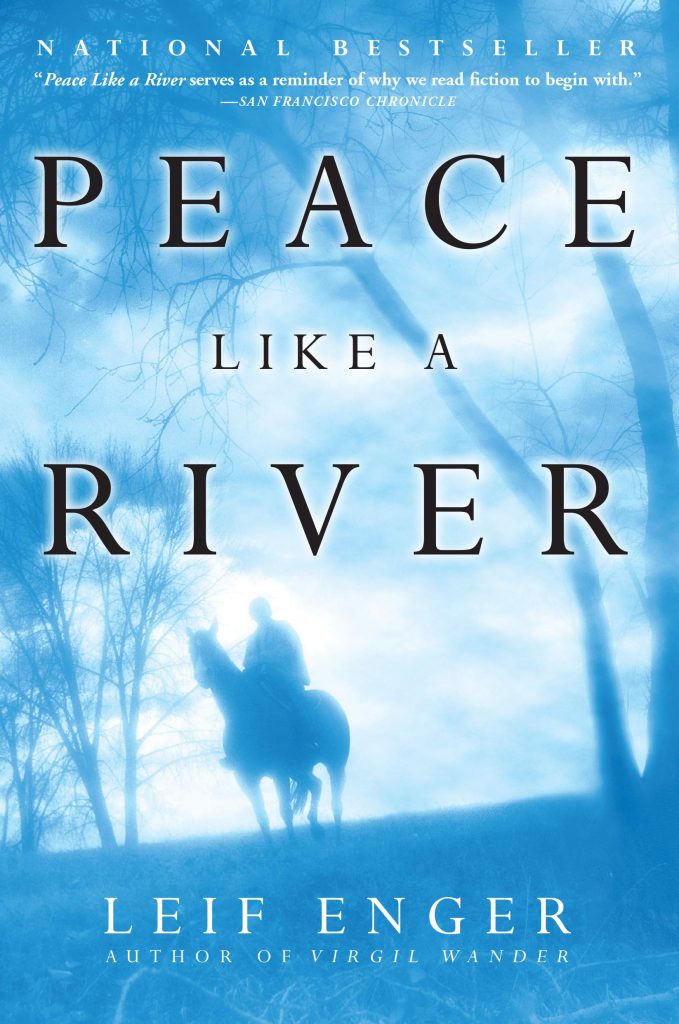High School American Literature: Often Dark and Depressing
When I arrived at college, I was absolutely, 100% convinced that British lit was my jam. American literature could stay on the shelf, for all I cared. Ironically, I adored my high school American literature teacher. I just didn’t enjoy what we read in class.
Sadly, my experience is not unique. Even for students who identify as readers, Melville, Hawthorne, and Hemingway are daunting. Our Town is depressing. The Scarlet Letter is an extended treatise on sin and guilt. The Red Badge of Courage is an extended, “realistic” portrayal of battle and war. Things don’t end well for Lenny. Tom Robinson doesn’t get away. Daisy dies. The marlin gets eaten by sharks. Guess what the ending to Death of a Salesman is? And so it goes.
The issue isn’t that these works aren’t worth reading (they most certainly are); the issue is the sheer amount of titles like these read all at once. A few years ago, Emily Whitten wrote a sobering series on typical high school book lists. So many books are just downright depressing and full of despair. When contemporary works are added or swapped in, the books chosen are no better. What’s the answer?


High School American Literature: A Better Approach
I’m back in the high school literature teacher position, but this time, it’s in a homeschool environment. And you know what I’ve realized in the intervening years since I last taught high school English? I like American literature! And how did I realize this, when for so many years I was utterly convinced I could do without? I read great books.
You know what else I’ve realized? As my co-worker Megan likes to say, “I don’t have to do it that way.” Sure, I want to prepare my students for college. Yes, I want them to have a solid survey of American literature. I agree that it’s important to read books that are classics, even if they are “dark.” Often, they have important things to teach us about our own sinful, human condition and about our need for grace. But we don’t have to only read the dark books.
Instead, we’ll read hopeful works alongside (fewer) dark works and wrestle with what a biblical faith has to say about the issues. That doesn’t mean we’ll only read about sunshine and bubbles; even hopeful works, if they’re honest, will show the effects of sin and the fall on this world God made. Thus, we must examine our own hearts and discuss the true source of hope, especially when the work in question doesn’t.
American Literature Survey Course
A survey course is designed to give students a broad overview of a culture’s literature. Generally, students start with the earliest works and progress to the present, reading a sampling of genres and authors throughout history. We will follow this approach and focus on the following skills, themes, and ideas as we read:
- Learn to discern worldview in the works, the culture, and the time periods we study
- Gain an understanding of, and appreciation for, some of the different voices and contributors to American literature
- Grow in our ability to conduct literary analysis of different genres
- Pay special attention to the development of the American dream and the ways in which individuals and groups of people see the “other” (in terms of race, class, religion, etc.)
- Develop composition skills, coordinating essay types to the dominant writing style of the literary time period.
I will have two 9th graders, one 10th grader, and one 11th grader. This is a robust course, to be sure, but my four students are avid readers and writers. I chose books, resources, and assignments based on the maturity of my students, the books they’ve already read, and their demonstrated reading and writing abilities. That’s a luxury I have as a home educator.
Fine print: this is not a published curriculum. I do not claim any authority to say what “counts” for a high school American literature credit, I cannot promise the list below will work for your situation, and I am not claiming that this course is better than one of the many pre-packaged American literature curricula on the market. But I do urge you to examine what your children and students are expected to read. Know your children and students, and do not feel obligated to read a book just because you feel like you “should,” especially if you think it unwise or unbiblical. Remember, we should read under grace, not law.
More fine print: Some links below are affiliate links; read our full disclosure for more information.
General and Reference Resources
- Reading With Purpose: Applying the Christian Worldview to American Literature by Nancy Wilson (in addition, we may use some of the Canon Press Worldview Guides)
- Adventures in American Literature, Pegasus Edition by Harcourt Brace (no longer in print, sadly!)*
- Select Compass Classroom American Literature lectures
- Wordsmith Craftsman
- Invitation to the Classics, edited by by Louise Cowan and Os Guiness (select chapters)
- On Reading Well by Karen Swallow Prior (select chapters)
*This textbook is part of my favorite teaching series from when I taught in the classroom. It has an excellent selection of American poetry, prose, and drama as well as thought-provoking analysis questions. In order to read a wide representation of authors, I intentionally chose to read authors like Hawthorne and Melville in short story form as opposed to reading one of their long novels. I appreciate the representation in this textbook.
Specific Literary Works


In addition to the short works we’ll pull from the textbook anthology, we’re going to read the following:
Summer Reading: The Chosen by Chaim Potok OR To Kill a Mockingbird by Harper Lee: students will choose one for summer reading. We will use these two books to start off our discussion of worldview as well as how an individual or group sees the “other.” Both are excellent modern American literary examples and well worth reading.
Puritan Time Period: Narrative of the Captivity and Restoration of Mrs. Mary Rowlandson plus select Native American tales from various sources. Mary Rowlandson’s work is the first published work in American literature by a woman, is saturated with biblical references, and, in addition to a gripping and harrowing tale, shows a remarkable willingness to view her captors as individuals. Students will work on a narrative essay following the guidelines in Wordsmith Craftsman.
Revolutionary War Time Period: all literature will come from our textbook. Students will write a persuasive essay, following the guidelines in Wordsmith Craftsman.


Civil War Time Period: The Narrative of the Life of Frederick Douglass. The American dream and how we see the “other” comes into sharp focus in Douglass’s narrative as we wrestle with slavery, freedom, and the image of God in humanity.
Reconstruction Time Period: The Adventures of Huckleberry Finn by Mark Twain: an American literature class standard with good reason, this work is important. Our students are going to college in a different intellectual climate than we did. If we do not discuss some of these “canceled” works from a biblical worldview, we are doing our students a disservice. Why do people want to cancel this work, what should we as Christians think about it, how do we read works that have historical racism in them, what makes for true freedom, and similar questions beg to be addressed. In addition to these weighty issues, Huckleberry Finn is a classic coming-of-age tale. Students will work on descriptive essays following the guidelines in Wordsmith Craftsman since Huckleberry Finn coincides with American realism (and much descriptive writing!).
Early Modern Time Period/Roaring Twenties: O Pioneers! by Willa Cather and The Great Gatsby: A Graphic Novel Adaptation: We will compare these two works and their vision of the American dream. A graphic novel for literature class? This provides a nice break from some of the other reading we’ll be doing, allows us to appreciate a very American literary genre (comic books and graphic novels), and provides for a good discussion on the intersection of text and images. Read more about what Hayley and I thought of this Great Gatsby graphic novel adaptation. Frankly, I’d rather spend more time with Willa Cather (in terms of both literary style and worldview) than with Fitzgerald anyway, so a graphic novel for The Great Gatsby is not a big sacrifice. During this time period, students will write an expository essay following the guidelines in Wordsmith Craftsman.


Modern Time Period: Our Town by Thornton Wilder. (Our version is included in our textbook, so I can’t speak to the particular edition linked). This is a somewhat depressing play, so part of our study will include a study of the biblical book of Ruth as the perfect foil (the two stories form mirror images in many ways). Students will begin a short research paper on an American poet, following the guidelines in Wordsmith Craftsman.
Postmodern Time Period: Peace Like a River: A Novel by Leif Enger. We’ll end our year with another coming-of-age tale that is a perfect capstone to our year. Another journey like Rowlandson’s. Another father-son story like The Chosen. Another story that reflects the loss of the American dream, but also a rich legacy gained as well.
What would YOU add or swap in for your own ideal high school American literature class? Tell us in the comments!
Stay Up to Date!
Get the information you need to make wise choices about books for your children and teens.
Our weekly newsletter includes our latest reviews, related links from around the web, a featured book list, book trivia, and more. We never sell your information. You may unsubscribe at any time.
Support our writers and help keep Redeemed Reader ad-free by joining the Redeemed Reader Fellowship.
Stay Up to Date!
Get the information you need to make wise choices about books for your children and teens.
Our weekly newsletter includes our latest reviews, related links from around the web, a featured book list, book trivia, and more. We never sell your information. You may unsubscribe at any time.
FREE Bible Guide!
Get a guide to the Best Bibles for Children and Teens. Perfect for an Easter gift.
We'd love to hear from you!
Our comments are now limited to our members (both Silver and Golden Key). Members, you just need to log in with your normal log-in credentials!
Not a member yet? You can join the Silver Key ($2.99/month) for a free 2-week trial. Cancel at any time. Find out more about membership here.
14 Comments
Leave a Comment
You must be logged in to post a comment.


Some of the novels you’ve added are ones we do in 9th & 10th grade. I teach American Lit to seniors in a small Christian school. (Our juniors take British Lit first as a foundation for American Lit.) For a number of years, my focus has been on the worldview and the historical/social/political context of the literature because the literature of every time and place reflects the culture and belief system behind the culture. (Often, it’s a sneak preview of where the rest of the culture is headed!) We look at the way the literature becomes darker as American society steps away from Biblical Christianity. Although Bob Jones and ABeka provide many of the selections I use, I also bring in other writers and poets that they don’t include. You might enjoy Daisy Miller (Henry James) as a look at how young people rebel against society’s expectations and O. Henry’s short stories as a fun change of pace with an ironic twist.
The age of the students definitely impacts what books to study (partly their maturity and partly what they’ve already read). I used to teach To Kill a Mockingbird to my ninth grade general lit class–one of my favorite novels for that age (although all of these books are profitable and enjoyable for adults as well). Thanks for the Daisy Miller suggestions; our textbook has that in it, so I’ll take a look (and it also has some O’Henry stories in it).
I definitely agree that young people need more positive and hopeful books as well as the deeper and darker ones in literature classes. I loved reading your list. My three oldest are all boys, and there have been some wonderful books I would like to add that were special favorites of theirs. The number one is Shane by Jack Shaeffer. My husband, schooled in Britain, remembered this as one of the only books that spoke to him in his schooling, and so we visited it several times in our homeschool. My husband read it to them when they were around middle school; they read it independently in high school and reflected on it and discussed it. Finally, my oldest son actually requested my husband read it aloud to all of us again when he was 16 or 17. It depicts life on the frontier and conflicts between the farmers and ranchers in 1889 Wyoming. It seemed to speak to something deep inside all of my boys that was distinctly male. The description of two men battling and removing a stump on the frontier is unforgettable.
Another frontier book set in Florida we enjoyed was The Yearling by Marjorie Rawlings. Again, it depicts a powerful relationship between father and son, and my husband read it aloud to all of us. We also did enjoy an abridged version of Moby Dick (Moby Dick as presented by Jan Needle) along with the short story, “Bartleby the Scrivener” which gave us an introduction to Melville. We included science fiction with Ender’s Game by Orson Scott Card, which led to wonderful discussion, and more modern American history with Unbroken by Lauren Hildebrand. Again, one of my sons was so moved by this book that he selected it for an extended family book discussion, which he ran.
The Yearling is great! And you’re right–Ender’s Game is so thought provoking. I’ve heard good things about Shane, too. Our textbook has Bartleby in it, and we will be reading it.
Do you think Reading With Purpose will prove helpful in any literature course? My ninth grader will be reading a variety of classic novels this year, not just American literature. I do want him to develop his ability to perceive worldviews well while reading. This book seems like it would provide a good starting point for understanding worldview. Thank you.
That’s a great question. The first 3-4 chapters are broad enough that they might be helpful as a general overview, but the bulk of the book examines the different periods in American literature in particular. Another book that is an excellent starting point for developing a Christian view of analysis is Echoes of Eden by Jerram Barrs. It addresses how Christians should evaluate literature from a Christian perspective more than diving into the worldviews in a given work, though. You might also consider one of the Worldview Guides from Canon Press if they have one of the books you’ll be reading.
Oh Betsy, we are kindred spirits indeed! I’m not teaching American Lit in the classroom any more, but your choices and thought processes resonated with so many of mine! So many of our book choices overlap, and for the same reasons! I pray you have a wonderful year. If I have any resources I can share, you are welcome to them. Email me.
-Renee
I would encourage a reading of the One Act script titled A Jury of Her Peers. A one act play is short enough that it can be read quickly, re-read carefully and it will provide a great discussion.
I am taking your lead for my American Literature class for my oldest two children this year and I’m really excited. I’m a middle school teacher by training, though (and a fellow Covenant alum) and I’m wondering what the daily/weekly interaction with the books looks like with your students. Questions? Discussion? Any lecture? Also, which works do you take from the Literature anthology? I’d love to know more. Thanks!
Hi Scharlie! So glad you’re inspired by my line-up! I’m afraid I can only give you an overview, but here’s the gist: we met once/week for 2 hours. Students brought commonplace entries, reading reflections, and anything else “assigned” in terms of writing. They were expected to be prepared for class discussion and analysis of literary works as well as peer editing of one another’s papers. Our time was a combination of short-ish “lectures,” lots of discussion, and writing workshop type exercises (including peer editing). They read/wrote daily on the other days of the week, often juggling one longer work (such as O Pioneers!) alongside poetry and short prose works. As for what to read in the anthology, a lot of that depends on your students: their reading abilities, familiarity with the authors/works represented, and their general maturity. I adapt the particulars of those anthologies every year I use them depending on who my students are. A good rule of thumb is to cover at least one work (more, if it’s poetry) from every author you recognize as being “famous” or “important” (i.e. Robert Frost, Nathaniel Hawthorne, Flannery O’Connor) alongside a good sampling of the unfamiliar in the time you have left. This means that you, as educator, need to do some reading ahead of time ;-). What serves your purposes best? I often had my students read all of the poems in the anthology for a given poet (say, Robert Frost) but just choose to actually explicate. During class, each student walked the rest of through “their” poem. Rarely did two students do the same poem! You could take the same approach with short stories if your time is short (have them pick a sampling that’s different from each other and then “present” or “teach” their stories to the rest of the group).
Thanks so much!That helps a lot. It’s already been a joy to discuss To Kill a Mockingbird (a favorite since I was probably a bit young for it) with my daughter and son. I’m actually excited about the work to get ready for this class. It’s a lot (esp. with younger students too), but so rewarding.
Oh, I’m so glad you’re excited! It’s worth the work ;-).
Killer Angles by Michael Shaara is a great civil war book!
I’ve heard that’s a great one!